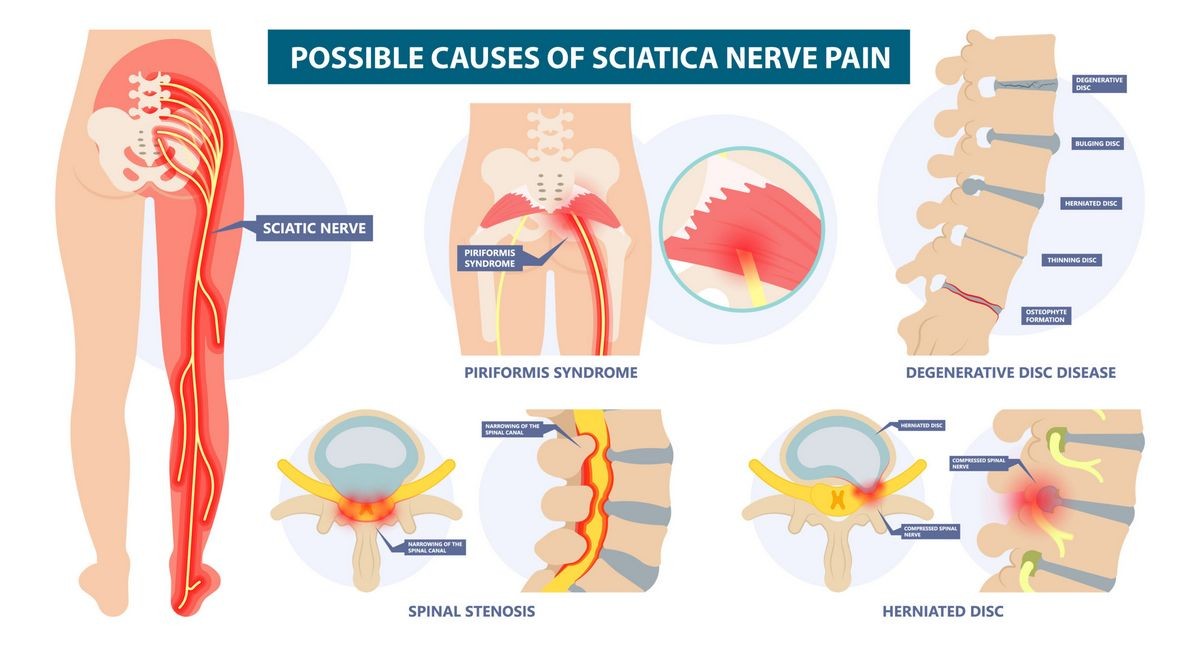
Contents
Sciatica
The pain of sciatica is typically felt from the low back (lumbar area) to behind the thigh and can radiate down below the knee.
Sciatica is a pain in the lower extremity resulting from irritation of the sciatic nerve. The sciatic nerve is the largest nerve in the body and begins from nerve roots in the lumbar spinal cord in the low back and extends through the buttock area to send nerve endings down the lower limb. Lumbar radiculopathy is sometimes referred to as sciatic nerve pain.
What are the 4 types of sciatica?
1. Acute sciatica
- Caused by sudden irritation to the nerves due to pinching, compression, or a combination of both.
- Symptoms may include: a burning or shooting sensation throughout the lower back, buttocks, and down the leg, hip pain, difficulty sitting as symptoms get worse.
2. Chronic sciatica
- Can last months or years and may occur intermittently.
- Some conditions that can worsen the pain include: inflammatory conditions (such as rheumatoid arthritis), injuries, infections, spinal misalignment issues.
3. Bilateral sciatica
- A rare type of sciatica that affects both legs.
- May be caused by multiple herniated discs or disc degeneration.
- The pain may be felt in both legs and buttocks at the same time.
- At times, pain in one leg might be more severe than pain in the other leg.
4. Alternative sciatica
- A rare type of sciatica that can cause pain in both legs alternatively.
- Can result from degenerative problems in the sacroiliac joint or sacroiliac arthritis.
What are the causes of sciatica?
Sciatica is most commonly caused by a lumbar disc herniation directly pressing on the nerve. Other causes of sciatica include irritation of the nerve from adjacent bone, tumors, muscle, internal bleeding, infections in or around the lumbar spine, spondylolisthesis, injury, spinal stenosis, cauda equina syndrome, osteophyte, and other causes. Sometimes it can occur during pregnancy as well.
Risk factors for sciatica include degenerative arthritis of the lumbar spine, lumbar disc disease, a herniated disc, and trauma or injury to the lumbar spine.
What are the symptoms of sciatica?
Sciatica often results in lumbar pain, buttock pain, hip pain, and leg pain. It can also cause a burning sensation, numbness, or tingling radiating from the lower back and upper buttock down the back of the thigh to the back of the leg. Sometimes the sciatic pain radiates around the hip or buttock and feels like hip pain. It is possible to have sciatica without low back pain. Severe sciatica can make walking difficult. Symptoms may be aggravated by walking or bending at the waist and relieved by lying down. Changing positions can provide partial or complete relief from numbness and pain.
QUESTION
Diagnosis of sciatica
Sciatica is diagnosed with a physical exam and medical history. Other tests, such as X-rays, CT scans, MRI scans, and electromyograms, may be used to further define the exact causes of sciatica. Physicians from various specialties evaluate and treat sciatica, including general medicine, family medicine, internal medicine, gynecology, orthopaedics, neurosurgery, rheumatology, pain management, and physiatry. Other healthcare providers for low back pain include physical therapists, chiropractors, massage therapists, psychologists, and acupuncturists.
What is the treatment for sciatica?
How can I get immediate relief from sciatica?
Bed rest has been advocated for the treatment of acute sciatica. However, a study showed that bed rest is not more effective than watchful waiting for patients with sciatica. Treatment options for sciatica depend on its cause and can include addressing the underlying cause and physical therapy. Other treatments may include transcutaneous nerve stimulators, low back conditioning and stretching exercises, various medications (pain relievers, muscle relaxants, anti-inflammatories, and antidepressants), cortisone medications, and surgical procedures in some cases. Sciatic flare-ups are often caused by herniated or slipped discs or bone spurs on the spine.
Home remedies and exercises for sciatica
Home remedies for acute sciatica include heat and cold pack topical administration, and over-the-counter pain medications such as acetaminophen, nonsteroidal anti-inflammatory drugs (NSAIDs), and aspirin. Physical therapy involving gradual exercises and stretching, as guided by physical therapists, can also help in managing sciatica. Core strengthening exercises and other techniques may be recommended. The prognosis for sciatica varies depending on its cause and duration. It can range from excellent to chronic symptoms. To some extent, sciatica can be prevented by avoiding low back trauma injuries and participating in conditioning exercises.
Sources:
Cass, Shane P. "Piriformis Syndrome: A Cause of Nondiscogenic Sciatica." Current Sports Medicine Reports 14:1 (41-44).
Firestein, Gary S., et al. Kelley’s Textbook of Rheumatology, Ninth Edition. China: Elsevier Health.
Vroomen, P.C., et al. "Conservative treatment of sciatica: a systematic review." J Spinal Disord 13(6) (463-469).


